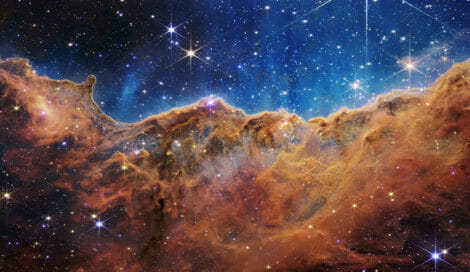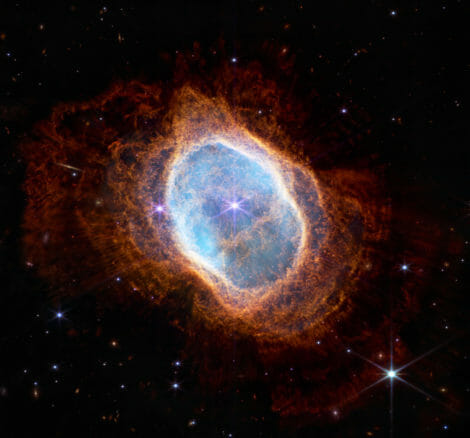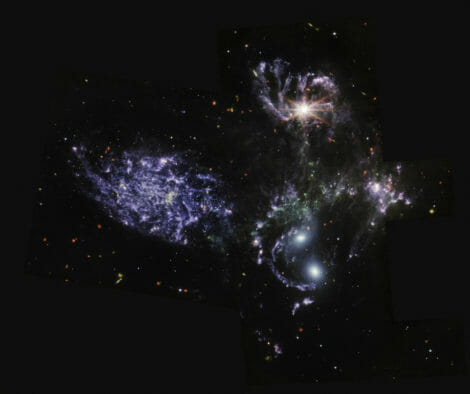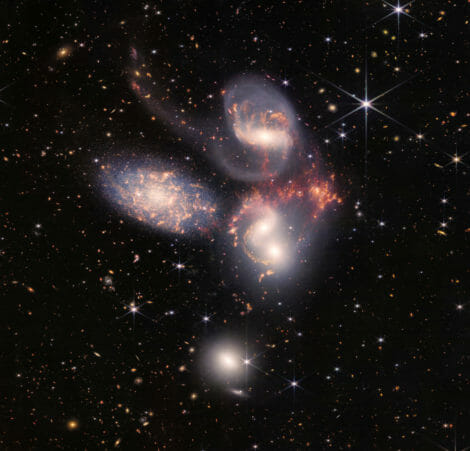

The “Cosmic Cliffs” of the Carina Nebula is seen in a picture divided horizontally by an undulating line between a cloudscape forming a nebula alongside the underside portion and a relatively clear higher portion, with information from NASA’s James Webb House Telescope, a revolutionary equipment designed to see by the cosmos to the daybreak of the universe and launched July 12, 2022. Speckled throughout each parts is a starfield, displaying innumerable stars of many sizes. NASA, ESA, CSA, STScI, Webb ERO Manufacturing Staff/Handout by way of REUTERS
GREENBELT, Md. — The {powerful} James Webb House Telescope’s inaugural batch of photos has opened a brand new chapter of cosmic exploration, however astronomers say the observatory’s most consequential discoveries could be these they’ve but to even think about.
Distant colliding galaxies, gas-giant exoplanets, and dying star techniques had been the primary celestial topics captured by the multibillion-dollar observatory, placing its big selection of infrared-imaging capabilities on colourful show and proving the telescope works as designed.
Webb’s gallery of early pictures and spectrographic information, which astronomers likened to the outcomes of mere “goal apply” as they readied the telescope for operational science, additionally previewed a number of deliberate areas of inquiry forward.
The competitively-selected agenda of analysis contains exploring the evolution of early galaxies, the life cycle of stars, the seek for liveable planets orbiting distant suns, and the composition of moons in our personal outer photo voltaic system.
However probably the most revolutionary findings by Webb, 100 instances extra delicate than its 30-year-old predecessor, the still-operational Hubble House Telescope, could change into unintended discoveries or solutions to questions astronomers have but to ask.
“Who is aware of what’s coming for JWST (James Webb House Telescope). However I’m positive we’re going to have lots of surprises,” René Doyon, principal investigator for certainly one of Webb’s devices, the Close to-Infrared Imager and Slitless Spectrograph, stated Tuesday at NASA’s Goddard House Flight Heart in Maryland, the place the company unveiled the observatory’s first full-color photos.

An statement of a planetary nebula from the NIRCam instrument of NASA’s James Webb House Telescope, a revolutionary equipment designed to see by the cosmos to the daybreak of the universe and launched July 12, 2022. NASA, ESA, CSA, STScI, Webb ERO Manufacturing Staff/Handout by way of REUTERS THIS IMAGE HAS BEEN SUPPLIED BY A THIRD PARTY.
With Webb open for enterprise seven months after its launch in December, astronomers are making ready for “one thing that’s on the market that we by no means guessed can be there in any respect,” stated John Mather, a Nobel Prize-winning senior astrophysicist at NASA whose work in the course of the Nineties helped cement cosmology’s “Large Bang” concept.
Darkish matter, darkish vitality
Mather and different scientists pointed to darkish matter, an invisible and little-understood however theoretically influential cosmic scaffolding, as an enigma that Webb would possibly unlock throughout its mission.
Hubble, likewise, opened a complete new discipline of astrophysics devoted to a different mysterious phenomenon, darkish vitality, as its observations of supernovas led to the surprising discovery that the universe’s growth is accelerating.
Taken collectively, darkish vitality and darkish matter at the moment are estimated by scientists to account for 95% of the recognized universe. All of the galaxies, planets, mud, gases, and different seen matter within the cosmos compose simply 5%.
“These had been enormous surprises,” Mather stated of early darkish matter and darkish vitality discoveries.

Stephan’s Quintet, a set of 5 galaxies, as seen by MIRI from NASA’s James Webb House Telescope, a revolutionary equipment designed to see by the cosmos to the daybreak of the universe and launched July 12, 2022. NASA, ESA, CSA, STScI, Webb ERO Manufacturing Staff/Handout by way of REUTERS
Amber Straughn, a deputy mission scientist working with Webb, stated: “It’s onerous to think about what we’d study with this hundred-times-more-powerful instrument that we actually don’t know but.”
Darkish matter already has figured prominently in Webb’s very first “deep discipline” picture, a composite picture of a distant galaxy cluster, SMACS 0723, that gives probably the most detailed glimpse up to now of the early universe due to a magnifying impact referred to as a gravitational lens.
The sheer mixed mass of galaxies and different unseen matter within the foreground of the picture warps the encircling area sufficient to amplify gentle coming from extra distant galaxies behind them, bringing into view fainter objects farther away, and thus additional again in time.
At the least one of many tiny specks of sunshine “photo-bombing” the sting of the image dates again 13.1 billion years, or practically 95% of the best way to the Large Bang, the theoretical cosmic flashpoint that put the universe in movement 13.8 billion years in the past.

A gaggle of 5 galaxies that seem shut to one another within the sky: two within the center, one towards the highest, one to the higher left, and one towards the underside are seen in a mosaic or composite of close to and mid-infrared information from NASA’s James Webb House Telescope, a revolutionary equipment designed to see by the cosmos to the daybreak of the universe and launched July 12, 2022. NASA, ESA, CSA, STScI, Webb ERO Manufacturing Staff/Handout by way of REUTERS
However as a result of the calculated mixed mass of all of the seen matter within the foreground is inadequate by itself to supply the faint round distortion seen within the picture, the lensing impact is agency oblique proof of darkish matter’s presence.
“It’s probably the most {powerful} software that we’ve got, astrophysically, to do this sort of lensing experiment,” stated Jane Rigby, a Webb operations mission scientist. “We will’t straight detect darkish matter, however we see its influence… we are able to see its results in motion.”
“The universe has been on the market, we simply needed to construct a telescope to see what was there,” she added.
New gentle was additionally shed unexpectedly from Webb’s first spectrographic evaluation of an exoplanet in a distant photo voltaic system, on this case, a gasoline big roughly the dimensions of Jupiter dubbed WASP-96 b.
Measuring the wavelengths from gentle filtered by the ambiance of the exoplanet because it orbited its personal solar clearly revealed the molecular signature of water vapor in clouds and haze, options scientists had been stunned to search out.
“There are discoveries in these information,” Webb program scientist Eric Smith stated. “We’re making discoveries and we actually haven’t even began making an attempt but.”
RELATED STORIES
Webb Telescope: What will scientists learn?
NASA draws back curtain on Webb space telescope’s first full-color images
The most recent tech information delivered to your inbox
Learn Subsequent
Subscribe to INQUIRER PLUS to get entry to The Philippine Each day Inquirer & different 70+ titles, share as much as 5 devices, hearken to the information, obtain as early as 4am & share articles on social media. Name 896 6000.









